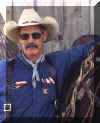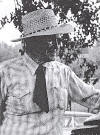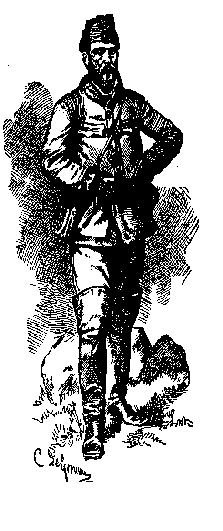
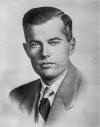
When the Communists seized control of China Mackiernan was ordered to evacuate. But conditions in the east had deteriorated so seriously that Mackiernan had only one option, escape by horseback across one of the worst deserts in the world and ride on to the still free Tibetan capital of Lhasa. Accompanying him on this hazardous journey would be Frank Bessac, a young American student turned espionage agent who had been patrolling the Chinese-Mongolian border, and three fervent Russian anti-communists including one named Vasili Zvansov.
Before this unlikely group saddled up, Mackiernan wired Washington DC to report that the communists were expected to seize Urumchi immediately. Then, with his official duty done, Mackiernan, Bessac and the Russians set off towards Tibet with their gear, which included machine guns, radios, gold bullion, navigation equipment, and survival supplies.
Having initially eluded their Chinese pursuers, when the equestrian escapees reached the Takla Makan Desert, Kazakh nomads advised the travellers that, because there was no pasture ahead, they could only proceed if they rode specially-trained, meat-eating horses. The Kazakh chief, Hussein Taiji, said that such horses were rare, and would cost twice as much. The diet of these extraordinary horses was another equine, the wild ass of Central Asia.
Vasili Zvansov later recalled, “We searched for three months amongst the Kazaks for these rare meat-eating horses. But when we found them we discovered they wouldn’t eat just any kind of meat – they would only eat the liver of the wild ass, known as the Gobi Kulan. We also learned we couldn’t feed them liver every day, or it would have killed them, so we fed them every few days. There was indeed no grass on the entire trip and only the horses which ate the liver survived the trip.”
Mounted on these specially trained horses, Mackiernan and his men managed to cross the notorious Takla Makan desert after great hardships. The spies turned Long Riders were then forced to ride up into the mighty Himalayas in order to reach Tibet. During the course of their journey Mackiernan had managed to radio Washington to report their progress. The American government in turn had sent word to the Dalai Lama’s government, asking the Tibetans to extend diplomatic sanctuary to Mackiernan and his men when they reached Lhasa.
The problem was that Mackiernan and his men were due to enter Tibet before any official word of greeting could be sent from the capital to the distant border post. Plus, MacKiernan’s group had no visible sign of authority. Under such rare conditions are disasters born. After having struggled over the Himalayas, Mackiernan, Bessac and the Russians believed their freedom was in sight. Before them lay the Tibetan outpost of Shigarhunglung, where they thought they would find safety. It was April 29th, 1950, Douglas Mackiernan’s birthday – and he was about to die.
According to recently released, previously top-secret American State Department documents obtained by The Long Riders’ Guild, Mackiernan and his men were attacked by the Tibetan border guards, who mistook the travellers for bandits or communists guerrillas. Mackiernan and two of the Russians were slain. They joined a long list of equestrian travellers that had been captured, tortured or killed in Tibet. Bessac and the remaining Russian, Vasili Zvansov, were wounded. The Tibetans then tied up the two survivors, threw them on their horses and began heading them towards the still distant Lhasa. Click here to read Bessac's journal.
Marching before the dazed Bessac was a baggage camel carrying a filthy sack. With his own life hanging by a thread the wounded American didn’t comment on what he knew was swinging back and forth before him, for his Long Rider comrade, Mackiernan, had been beheaded on his birthday. And that grisly trophy, along with the heads of the deceased Russians, now led the way to Lhasa.
With Bessac captive and radio contact broken off, rumours began swirling across Central Asia that Mackiernan may have been wounded or slain. Washington attempted to enlist the aid of Scottish Long Rider George Patterson to find the missing Mackiernan. Knowing of Patterson’s intimate knowledge of the country and his ability to speak Tibetan fluently, the American State Department believed the Scottish Long Rider might be able to locate Mackiernan and guide the missing agent and his men to safety. Yet before Patterson could set off, word reached Washington that though Bessac had reached Lhasa alive, Mackiernan had been slain.
The Dalai Lama’s government expressed official sorrow at the murderous border mix-up. In an ironic Tibetan twist of fate, even though Douglas Mackiernan was the first CIA agent killed in the line of duty, his work remains so sensitive that the Agency still refuses to either confirm or deny his existence. To learn more about the death of this James Bond style Long Rider, The Guild recommends, “Into Tibet: The CIA’s First Atomic Spy and His Secret Expedition to Lhasa,” by Thomas Laird.
There is an amazing equestrian epilogue to Mackiernan’s story. In 1954 National Geographic magazine documented how Kazakh chief Qali Beg led his tribe 3,000 miles from Sinkiang, China to safety in Kashmir, India. Part of the tribe’s journey was made on specially trained meat-eating horses, which were able to survive in the grassless Takla Makan desert!
Yet these outdoor activities only developed Maillart’s insatiable curiosity to travel east, leaving behind the confines of her early life in Geneva in search of the perfect life that she was instinctively seeking. Her later adventures took her across many continents and various oceans. Maillart sailed the Mediterranean in a yawl, traveled with famed travel English travel writer Peter Fleming from Peking to Kashmir, explored Tibet with a half-wild tiger-cat in search of spiritual enlightenment, and finally drove 4,000 miles from war-torn Europe to the fabled Khyber Pass in a battered Ford car. Yet her solo journey through Central Asia in the early 1930s was considered to be a highlight of her adventure-filled life. Setting off from the Tien Shan mountains of Mongolia, Maillart rode horses and camels to the far away walls of fabled Bokhara. Turkestan Solo is her vivid account of this wonderful, mysterious and dangerous portion of the world, complete with its Kirghiz eagle hunters, lurking Soviet secret police, and the timeless nomads that still inhabited the desolate steppes of Central Asia.
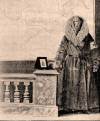
Seldom does an equestrian travel tale require its readers to exert more intellectual caution than this superbly written book. For herein lies a story whose message of intolerance is once again afoot in the world. True enough, young British officer Hippisley Cunliffe Marsh evaded plenty of danger in the way of Turkoman slave traders and other villains as he made his wary way from Turkey to India. Moreover, being a keen horseman, the Bengal Lancer made sure to note the equestrian practices of the countries he rode through. “The Turkoman horses are specially trained on little food and less water for a month previous to an expedition; and once they start the horse gets large quantities of a mixture of one-half barley, one quarter maize, and one quarter sheep’s fat, all made into a soft mass of eight pounds, on which the horse is able to do a hundred miles a day for several days,” Captain Marsh noted. With the decline of the Turkish, Persian, Afghan and Mughal kingdoms, the military might of the British Raj was in its ascendancy. With this rise in power, officers like Marsh harbored a corresponding belief in their personal superiority. The result was a long slide into religious and cultural bigotry. On arriving at the holy city of Meshed, Persia, for example, Marsh was detained at the gates by guards intent on inspecting his saddlebags. Adhering to the belief that Europeans were exempt from local legalities, the author, “struck the rascal holding my horse with my whip, leaving him bellowing on the ground.” Throughout history, the world of equestrian travel has been peopled by wise men and women. Their journeys taught them that custom and appearance count for little and that the perils of equestrian travel unite all Long Riders as they attempt to survive hunger, cold and danger. Such a bond of equestrian brotherhood has no room for the religious and political bigotry found in this book. Yet in this time of global woe, when the Islamic world is being devalued by a new generation of Sahibs who cherish the myth of their national superiority, Marsh’s A Ride through Islam reads like a warning from the grave.
Violet Martin and Edith Somerville were the two fun-loving, hard-riding, co-writing female cousins who penned a total of fourteen books, including their immortal classic, Some Experiences of an Irish R. M. While readers of that generation would have recognised the names of the co-authors' pseudonyms, “Martin Ross” and “E. Œ. Somerville,” few knew that the books were actually the pen names of these light-hearted Irish Long Riders. Their most famous equestrian work was entitled Beggars on Horseback. This delightful book recalls how the high-spirited young ladies decided to tour North Wales on horseback. Finding suitable horses was their first task: even in 1894 this was no easy matter, especially when they explained why they needed them: “We were conscious of social shrinkage as the work for which we required the ponies was explained; a fortnight’s road work in Wales, with the proviso that the animals would have to carry packs, held a suggestion of bagmen, not to say tinkers.” They were both avid horsewomen, and in due course they hired two ponies who have pride of place in this enchanting tale.

The Old West was populated by a host of colourful characters
including gunfighters, cowboys, buffalo hunters, sod busters, and at least
one cavalry officer with the eye of an eagle and a penchant for fine
writing. Colonel James Meline was an educated New York
journalist, turned pony soldier, who had fought for the Union during the
recent Civil War. With the country lulled into an uncomfortable peace, the
fifty-four year old Meline decided to partake of one last mounted adventure
before he hung up his spurs. Lucky
for the history of equestrian travel that he did. The resultant book,
Two Thousand Miles on Horseback
is a beautifully written,
eye witness account of a United States that is no more. Meline was no fool.
He sensed that the great American wilderness was about to be tamed. Setting
out from Fort Leavenworth in the summer of 1866, Meline observed a nation on
the move. In his first week in the saddle Meline counted 680 wagons heading
west. Moreover, he warned, “the iron rail will soon clamp East and West,
leaving no room for adventure or personal freedom.” Meline faithfully recorded the details of
prairie life seen during his ride to Santa Fe. Once he reached fabled New
Mexico the saddle-borne scribe fell in with Kit Carson. What followed was a
three day marathon interview wherein the legendary frontiersman regaled the
cavalry journalist with tales of fighting the Navajo, hunting gigantic
grizzly bears, and eluding capture by Indians. Then, with his notebooks
full, Meline headed home, experiencing a storm on the way that was so cold
that “even my memory froze.” Though the frontier they inhabited is a thing
of the past, Meline and his cast of mounted characters still jump off the
pages and dare you to ride down the road of adventure with them.
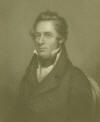
Beginning in 1789, French Long Rider Francois André Michaux (1770–1855) spent a dozen years exploring the United States in an attempt to document the distribution of the principal American timber trees east of the Rocky Mountains and north of Mexico. He often rode along obscure trails blazed by the Native Americans. In 1811 Michaux published his monumental work, The North American Sylva, which became a landmark in American literature and laid the foundation for modern American forestry.
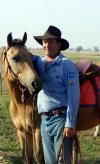
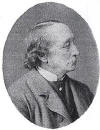
In 1839 Edward Mitford set off on what was to become the most remarkable equestrian journey of the 19th century. Layard departed from England with Austen Henry Layard. Their destination was Ceylon, which was 7,000 miles away. The two young men survived a remarkable series of adventures. They were held hostage by a giant robber chieftain in Montenegro. After obtaining a royal firman from the Sultan of the Ottoman Empire, Layard and Mitford explored the Middle East, were they drew and documented the remains of Roman and Greek civilisations. Their next destination was the ancient country of Assyria, today’s modern Iraq. Both men were keen amateur archaeologists who investigated ruins they found in the countryside. They then rode into Persia, with the intention of continuing across Afghanistan and through the Khyber Pass into British Raj India. When the Persian Shah refused to grant them permission to take the route they chose, Layard decided to return to Assyria to carry out more excavations. Upon his return, Layard discovered the ancient city of Nimrud and travelled with the nomadic Bakhtiari nomads.
Mitford continued his remarkable equestrian journey. He is the first Long Rider to leave a written record of how nomadic horsemen did not automatically remove the saddle from a horse which had become overheated while riding, preferring to leave the saddle in place until the animal had cooled.
His passage through Afghanistan was particularly perilous. Originally he had wished to ride from Heart to Kabul, then through the Khyber Pass to Peshawar. But this route was denied him by the Afghani authorities. Instead Mitford was forced to ride south via Kandahar and towards Quetta. During his ride through the Kojuk Pass, Mitford recalled how the bottom of the ravine was filled with the bones of horses that had fallen off the perilous trail. His journey took him on through Balochistan and into India in 1842. Soon after arriving in that country, Mitford learned that 4,500 British soldiers and 12.000 civilians stationed in Afghanistan had been massacred by the rebellious natives. Had Mitford followed his original route to Kabul, he believed he would have been among the fallen. Having ridden 7,000 miles from England, he weary traveller at last reached Ceylon. Yet his troubles were not at an end. Mitford was nearing his final destination when he became violently sick. “I was taken ill in the night, apparently with cholera; after very great suffering, being utterly without help or assistance, I resolved to try what violent exercise might effect, and mounting my horse, I galloped at speed to the next rest house, although I was compelled to dismount and throw myself on the ground in agony when the fits came on; I persevered, and the violent exercise under a tropical sun succeeded in throwing off the attack.”
In his book, “A Land March from England to Ceylon,” Mitford recalled how his remarkable ride had taken two years and ten months, during which time he had averaged 30 miles a day, and sometimes ridden nearly a hundred miles in 24 hours.

In the mid-nineteenth century German-born Heinrich Möllhausen made four extensive journeys across the still unexplored frontier of North America. He made journeys with two federal exploring parties and then accompanied a German prince onto the prairies for a third time. In the fall of 1857 Möllhausen explored the Colorado river and the Grand Canyon. When that portion of his journey was completed, the German Long Rider set out to ride from eastern Arizona to Fort Leavenworth via the Santa Fe trail. Upon his return to Germany, Möllhausen wrote an account of this historic journey. That story, translated for the first time into English, may be viewed here:
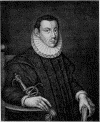
Down through ages Long Rider authors have created a number of remarkable books. Yet the record for having authored the most extensive travel account must surely be granted to English equestrian traveller Fynes Moryson (1566–1630).
Being the son of a wealthy Lincolnshire gentleman and Member of Parliament allowed Moryson to attend Cambridge University. But having graduated, he didn’t waste any time staying in England. As one biographer wrote, “from his tender youth, he had a great desire to see foreign countries,” so the young scholar obtained a license to travel from his government and immediately departed for parts unknown.
What resulted can be described as an explosion of travel. Between 1591 and 1597 the indefatigable Moryson roamed, witnessed, rode and wrote his way through a host of countries and principalities.
His journey first took him to all parts of continental Europe but his ambitions couldn’t be satisfied, so he travelled on to Jerusalem, Tripoli, Antioch, Aleppo and Crete.
Moryson was never content to merely visit a place. He delighted in observing local customs, studying economic institutions, interviewing important personages, and inspecting antiquities. Rome, Berlin, Constantinople, he knew them all intimately and many more.
What makes Moryson of special interest as a Long Rider is not merely that he rode so many miles to such a wide variety of countries but that in his usual methodical manner he preserved some of the earliest details about European equestrian travel.
At Dresden, Germany, Moryson was granted a special tour of the ruler’s magnificent stable. He later wrote, “The Elector’s stable is by much the fairest I ever saw. In the first court there is a horse-bath into which they may bring as much or as little water as they like. There is a tilting-yard and all exercises of horsemanship; and there is also the horse-leaches shop, so well furnished as if it belonged to a rich apothecary. Therein reside 136 rare horses. These horses are all of foreign countries. Among these chief horses is one named “Michael the Treasure,” who was said to be of wonderful swiftness. Before each horse’s nose was a glass window with a curtain of green cloth which could be drawn at pleasure. Each horse was covered with a red mantle.”
Moryson was no soft Sunday afternoon trail rider. His journeys required a degree of courage and strength seldom seen today.
While riding through the forests of Germany he had to hire a guide to avoid the bands of thieves waiting to waylay him. Some countries were harder than others. After finally reaching Zurich Switzerland in 1592 he wrote, “The miles of Switzerland are so long that they reckon the journey on horseback by the hours not by the miles.”
One of the strangest equestrian sights the inquisitive Long Rider recorded occurred during his ride from Vienna, Austria to Italy, when he met caravans of pack horses who were burdened with casks of exceptionally strong wine.
“I observed that the horses we met laden with wine had their noses covered lest they be overcome by the vapours of the wine.”
After many years and thousands of miles in the saddle, Moryson eventually returned to England, where he set about composing his mammoth work, the five volume work entitled, An Itinerary: Containing Ten Years Travel Through Germany, Bohemia, Switzerland, Netherlands, Denmark, Poland, Italy, Turkey, France, England, Scotland and Ireland. This giant work included Moryson’s notes on what type of horses were to be found in each region, how much they cost to hire and feed and what dangers lay along each part of the route
Here is a link to Moser's page in the Library section of this website.
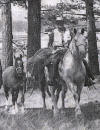
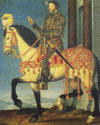
Hieronymous Münzer - Born in Germany in 1437, he was a humanist scholar, physician and Town Councillor in Nüremberg. In 1494 he and three friends embarked on a journey, on horseback, to visit the Iberian Peninsular. Münzer authored one of the earliest printed maps of Europe and in 1493 he wrote to the Portuguese King arguing that the eastern coast of Asia could be reached from the Atlantic coasts of Europe and Africa within a few days. He poured scorn on "inexperienced" people who tried to prove that the Ocean covered three quarters of the world. The mistaken Long Rider died in 1508.
